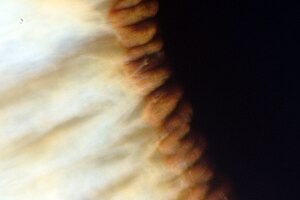Mechanical anisocoria
| Mechanical anisocoria | |
|---|---|
 | |
| Iris Dilator Muscle | |
| Specialty | Ophthalmology |
In mechanical anisocoria, this is the result of damage to the iris dilator muscle, which may be caused by trauma, angle-closure glaucoma, surgery such as cataract removal, or uveitis (inflammation of the eye). Slit lamp examination is often used as a diagnostic aid: damage to the dilator muscle is indicated by anisocoria when light intensity is lowered.[1] Anisocoria refers to a common eye condition in which the two pupils differ in size.
References[]
- ^ Mechanical Anisocoria. "Causes of Anisocoria". Medscape. Retrieved 3 November 2015.
Categories:
- Diseases of the eye and adnexa
- Disease stubs
- Eye stubs